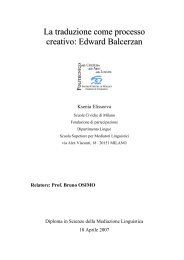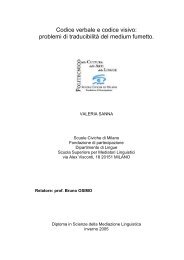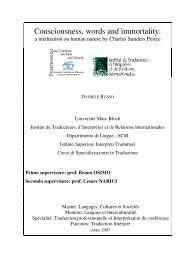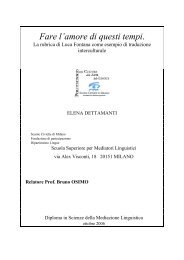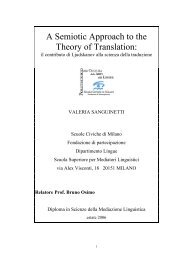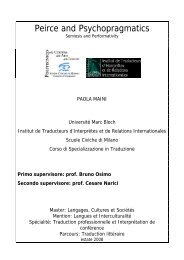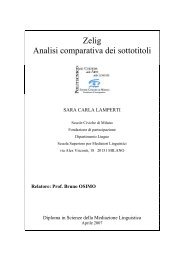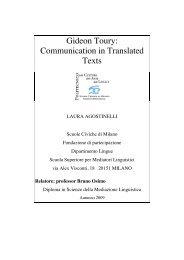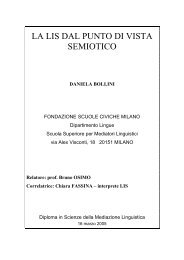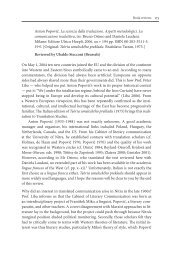Ksenia Elisseeva - Bruno Osimo, traduzioni, semiotica della ...
Ksenia Elisseeva - Bruno Osimo, traduzioni, semiotica della ...
Ksenia Elisseeva - Bruno Osimo, traduzioni, semiotica della ...
Create successful ePaper yourself
Turn your PDF publications into a flip-book with our unique Google optimized e-Paper software.
the ban is imposed on the hero, and not on the antagonist or donor; the<br />
antagonist is precisely the one who is properly punished (the thirtieth function)<br />
and not the hero or his helper. Syncretic thought operated by using integral<br />
segments that themselves represented short plots and that passed undivided<br />
from tale to tale, and therefore further differentiation of Propp's functions would<br />
be senseless.<br />
The increasing complication of life and the emergence of an elemental<br />
dialectics in thought led to a more flexible and free correlation in the artist's<br />
consciousness between the separate elements of a function, as well as to the<br />
appearance of many completely new elements and functions. It would be very<br />
valuable to analyze the process of disassociation of motif-functions into more<br />
minute units and the emergence of new motif-functions as it takes place over<br />
the course of many centuries; for instance, the plot of Puškin's Ruslan i Lûdmila<br />
could be compared, by using Propp's method, with traditional fairy tale plots. A<br />
characteristic feature of modern literature is the disassociation of motifs into<br />
their component parts or submotifs, which enter into free interactions with each<br />
other as subjects and predicates. Growth in the number of elements increases<br />
proportionally to the number of ties between them, which in turn complicates the<br />
structure as a whole. Therefore, attempts to reduce all the diversity of world<br />
dramaturgy to three dozen or so plots are naïve (see Polty 1895).<br />
Although the origin of cartomancy dates from extreme antiquity,<br />
contemporary cartomantic systems are the fruit of a new era. In them, each<br />
card is not a motif or “little plot”, but an element that only generates a plot in<br />
conjunction with other elements. In turn, each element or card cannot be<br />
divided further, and all thirty-six cards are indivisible elements. It is very difficult<br />
to classify these elements without taking into consideration the common division<br />
into subjects (face cards) and predicates (actions or states). No hierarchy based<br />
on suit or denomination, aesthetic or ethical categories, can be observed in our<br />
system. The feebly outlined opposition in face cards between the sexes, and<br />
the contrast in suits between old and young, married and unmarried, is entirely<br />
absent in predicates. Predicates can be conventionally grouped in twelve<br />
categories,<br />
20



